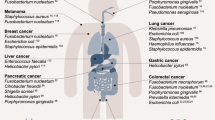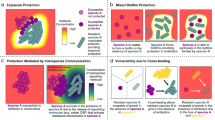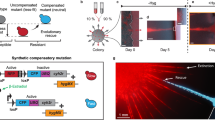Abstract
Cancer cells rapidly evolve drug resistance through somatic evolution and, in order to continue growth in the metastatic phase, violate the organism-wide consensus of regulated growth and beneficial communal interactions. We suggest that there is a fundamental mechanistic connection between the rapid evolution of resistance to chemotherapy in cellular communities within malignant tissues and the rapid evolution of antibiotic resistance in bacterial communities. We propose that this evolution is the result of a programmed and collective stress response performed by interacting cells, and that, given this fundamental connection, studying bacterial communities can provide deeper insights into the dynamics of adaptation and the evolution of cells within tumours.
This is a preview of subscription content, access via your institution
Access options
Subscribe to this journal
Receive 12 print issues and online access
$209.00 per year
only $17.42 per issue
Buy this article
- Purchase on Springer Link
- Instant access to full article PDF
Prices may be subject to local taxes which are calculated during checkout




Similar content being viewed by others
References
Hanahan, D. & Weinberg, R. A. The hallmarks of cancer. Cell 100, 57–70 (2000).
Ellis, L. M. & Hicklin, D. J. VEGF-targeted therapy: mechanisms of anti-tumour activity. Nature Rev. Cancer 8, 579–591 (2008).
Weinstein, I. B. & Joe, A. Oncogene addiction. Cancer Res. 68, 3077–3080 (2008).
Letai, A. G. Diagnosing and exploiting cancer's addiction to blocks in apoptosis. Nature Rev. Cancer 8, 121–132 (2008).
Kamb, A., Wee, S. & Lengauer, C. Why is cancer drug discovery so difficult? Nature Rev. Drug Discov. 6, 115–120 (2007).
Lage, H. An overview of cancer multidrug resistance: a still unsolved problem. Cell. Mol. Life Sci. 65, 3145–3167 (2008).
Butler, M. T., Wang, Q. & Harshey, R. M. Cell density and mobility protect swarming bacteria against antibiotics. Proc. Natl Acad. Sci. USA 107, 3776–3781 (2010).
Ahmed, N., Abubaker, K., Findlay, J. & Quinn, M. Epithelial mesenchymal transition and cancer stem cell-like phenotypes facilitate chemoresistance in recurrent ovarian cancer. Curr. Cancer Drug Targets 10, 268–278 (2010).
Stewart, P. S. & Costerton, J. W. Antibiotic resistance of bacteria in biofilms. Lancet 358, 135–138 (2001).
Tong, R. T. et al. Vascular normalization by vascular endothelial growth factor receptor 2 blockade induces a pressure gradient across the vasculature and improves drug penetration in tumors. Cancer Res. 64, 3731–3736 (2004).
Bock, K. D., Cauwenberghs, S. & Carmeliet, P. Vessel abnormalization: another hallmark of cancer? Molecular mechanisms and therapeutic implications. Curr. Opin. Genet. Dev. 21, 73–79 (2011).
Balaban, N. Q., Merrin, J., Chait, R., Kowalik, L. & Leibler, S. Bacterial persistence as a phenotypic switch. Science 305, 1622–1625 (2004).
Sharma, S. V. et al. A Chromatin-mediated reversible drug-tolerant state in cancer cell subpopulations. Cell 141, 69–80 (2010).
Alonso, A., Campanario, E. & Martinez, J. L. Emergence of multidrug-resistant mutants is increased under antibiotic selective pressure in Pseudomonas aeruginosa. Microbiology 145, 2857–2862 (1999).
Cirz, R. T. et al. Inhibition of mutation and combating the evolution of antibiotic resistance. PLoS Biol. 3, e176 (2005).
Schimke, R., Kaufman, R., Alt, F. & Kellems, R. Gene amplification and drug resistance in cultured murine cells. Science 202, 1051–1055 (1978).
Longley, D. B. & Johnston, P. G. Molecular mechanisms of drug resistance. J. Pathol. 205, 275–292 (2005).
Sniegowski, P. D. & Murphy, H. A. Evolvability. Curr. Biol. 16, R831–R834 (2006).
Bielas, J. H., Loeb, K. R., Rubin, B. P., True, L. D. & Loeb, L. A. Human cancers express a mutator phenotype. Proc. Natl Acad. Sci. USA 103, 18238–18242 (2006).
Bjedov, I. et al. Stress-induced mutagenesis in bacteria. Science 300, 1404–1409 (2003).
Earl, D. J. & Deem, M. W. Evolvability is a selectable trait. Proc. Natl Acad. Sci. USA 101, 11531–11536 (2004).
Draghi, J. A., Parsons, T. L., Wagner, G. P. & Plotkin, J. B. Mutational robustness can facilitate adaptation. Nature 463, 353–355 (2010).
Sniegowski, P. D., Gerrish, P. J. & Lenski, R. E. Evolution of high mutation rates in experimental populations of, E. coli. Nature 387, 703–705 (1997).
Giraud, A. et al. Costs and benefits of high mutation rates: adaptive evolution of bacteria in the mouse gut. Science 291, 2606–2608 (2001).
Ponder, R. G., Fonville, N. C. & Rosenberg, S. M. A switch from high-fidelity to error-prone DNA double-strand break repair underlies stress-induced mutation. Mol. Cell 19, 791–804 (2005).
Gonzalez, C. et al. Mutability and importance of a hypermutable cell subpopulation that produces stress-induced mutants in Escherichia coli. PLoS Genet. 4, e1000208 (2008).
Drlica, K. & Zhao, X. DNA gyrase, topoisomerase IV, and the 4-quinolones. Microbiol. Mol. Biol. Rev. 61, 377–392 (1997).
Viswanathan, A., You, H. & Doetsch, P. Phenotypic change caused by transcriptional bypass of uracil in nondividing cells. Science 284, 159–162 (1999).
Lengauer, C., Kinzler, K. W. & Vogelstein, B. Genetic instabilities in human cancers. Nature 396, 643–649 (1998).
Saxowsky, T. T., Meadows, K. L., Klungland, A. & Doetsch, P. W. 8-oxoguanine-mediated transcriptional mutagenesis causes ras activation in mammalian cells. Proc. Natl Acad. Sci. USA 105, 18877–18882 (2008).
Ma, L. et al. Assembly and development of the Pseudomonas aeruginosa biofilm matrix. PLoS Pathog. 5, e1000354 (2009).
Stewart, P. S. Diffusion in biofilms. J. Bacteriol. 185, 1485–1491 (2003).
Rani, S. A. et al. Spatial patterns of DNA replication, protein synthesis, and oxygen concentration within bacterial biofilms reveal diverse physiological states. J. Bacteriol. 189, 4223–4233 (2007).
Driffield, K., Miller, K., Bostock, J. M., O.' Neill, A. J. & Chopra, I. Increased mutability of Pseudomonas aeruginosa in biofilms. J. Antimicrob. Chemother. 61, 1053–1056 (2008).
Oliver, A., Canton, R., Campo, P., Baquero, F. & Blazquez, J. High frequency of hypermutable Pseudomonas aeruginosa in cystic fibrosis lung infection. Science 288, 1251–1253 (2000).
Boles, B. R. & Singh, P. K. Endogenous oxidative stress produces diversity and adaptability in biofilm communities. Proc. Natl Acad. Sci. USA 105, 12503–12508 (2008).
Macia, M. D. et al. Hypermutation is a key factor in development of multiple-antimicrobial resistance in Pseudomonas aeruginosa strains causing chronic lung infections. Antimicrob. Agents Chemother. 49, 3382–3386 (2005).
Taddei, F. et al. Role of mutator alleles in adaptive evolution. Nature 387, 700–702 (1997).
Liotta, L. A. & Kohn, E. C. The microenvironment of the tumour–host interface. Nature 411, 375–379 (2001).
Joyce, J. A. & Pollard, J. W. Microenvironmental regulation of metastasis. Nature Rev. Cancer 9, 239–252 (2009).
Kalluri, R. & Zeisberg, M. Fibroblasts in cancer. Nature Rev. Cancer 6, 392–401 (2006).
Sethi, T. et al. Extracellular matrix proteins protect small cell lung cancer cells against apoptosis: a mechanism for small cell lung cancer growth and drug resistance in vivo. Nature Med. 5, 662–668 (1999).
Rintoul, R. & Sethi, T. Extracellular matrix regulation of drug resistance in small-cell lung cancer. Clin. Sci. 102, 417–424 (2002).
Tredan, O., Galmarini, C. M., Patel, K. & Tannock, I. F. Drug resistance and the solid tumor microenvironment. J. Natl Cancer Inst. 99, 1441–1454 (2007).
Gatenby, R. A. & Gillies, R. J. Why do cancers have high aerobic glycolysis? Nature Rev. Cancer 4, 891–899 (2004).
Tlsty, T. D. & Coussens, L. M. Tumor stroma and regulation of cancer development. Annu. Rev. Pathol. 1, 119–150 (2006).
Koukourakis, M. I., Giatromanolaki, A., Harris, A. L. & Sivridis, E. Comparison of metabolic pathways between cancer cells and stromal cells in colorectal carcinomas: a metabolic survival role for tumor-associated stroma. Cancer Res. 66, 632–637 (2006).
Kansal, A. R., Torquato, S., Chiocca, E. A. & Deisboeck, T. S. Emergence of a subpopulation in a computational model of tumor growth. J. Theoret. Biol. 207, 431–441 (2000).
Bellomo, N., Li, N. & Maini, P. On the foundations of cancer modelling: selected topics, speculations, and perspectives. Math. Models Meth. Appl. Sci. 18, 593–646 (2008).
Kim, M. et al. Tumor self-seeding by circulating cancer cells. Cell 139, 1315–1326 (2009).
Tourovskaia, A., Figueroa-Masot, X. & Folch, A. Differentiation-on-a-chip: a microfluidic platform for long-term cell culture studies. Lab. Chip 5, 14–19 (2005).
Kimura, H., Yamamoto, T., Sakai, H., Sakai, Y. & Fujii, T. An integrated microfluidic system for long-term perfusion culture and on-line monitoring of intestinal tissue models. Lab. Chip 8, 741–746 (2008).
Liu, L. et al. A microfluidic device for continuous cancer cell culture and passage with hydrodynamic forces. Lab. Chip 10, 1807–1813 (2010).
Groisman, A. et al. A microfluidic chemostat for experiments with bacterial and yeast cells. Nature Meth. 2, 685–689 (2005).
Balagadde, F. K., You, L., Hansen, C. L., Arnold, F. H. & Quake, S. R. Long-term monitoring of bacteria undergoing programmed population control in a microchemostat. Science 309, 137–140 (2005).
Austin, R. H., Tung, C. K., Lambert, G., Liao, D. & Gong, X. An introduction to micro-ecology patches. Chem. Soc. Rev. 39, 1049–1059 (2010).
Hermsen, R. & Hwa, T. Sources and sinks: a stochastic model of evolution in heterogeneous environments. Phys. Rev. Lett. 105, 248104 (2010).
Maley, C. C. et al. The combination of genetic instability and clonal expansion predicts progression to esophageal adenocarcinoma. Cancer Res. 64, 7629–7633 (2004).
Maley, C. C. et al. Genetic clonal diversity predicts progression to esophageal adenocarcinoma. Nature Genet. 38, 468–473 (2006).
Conibear, T. C. R., Collins, S. L. & Webb, J. S. Role of mutation in Pseudomonas aeruginosa biofilm development. PLoS ONE 4, e6289 (2009).
West, S. A., Griffin, A. S., Gardner, A. & Diggle, S. P. Social evolution theory for microorganisms. Nature Rev. Microbiol. 4, 597–607 (2006).
Lee, H. H., Molla, M. N., Cantor, C. R. & Collins, J. J. Bacterial charity work leads to population-wide resistance. Nature 467, 82–85 (2010).
Fordyce, C. et al. DNA damage drives an activin A-dependent induction of cyclooxygenase-2 in premalignant cells and lesions. Cancer Prev. Res. 3, 190–201 (2010).
Hickson, J. et al. Societal interactions in ovarian cancer metastasis: a quorum-sensing hypothesis. Clin. Exp. Metastasis 26, 67–76 (2008).
Miller, M. B. & Bassler, B. L. Quorum sensing in bacteria. Annu. Rev. Microbiol. 55, 165–199 (2001).
Smith, J. M. Evolution and the Theory of Games 1st edn (Cambridge Univ. Press, Cambridge, UK,1982).
Hahn, W. C. & Weinberg, R. A. Modelling the molecular circuitry of cancer. Nature Rev. Cancer 2, 331–341 (2002).
Loewen, P. C. & Hengge-Aronis, R. The role of the sigma factor sigmas (KatF) in bacterial global regulation. Annu. Rev. Microbiol. 48, 53–80 (1994).
Zambrano, M., Siegele, D., Almiron, M., Tormo, A. & Kolter, R. Microbial competition: Escherichia coli mutants that take over stationary phase cultures. Science 259, 1757–1760 (1993).
Keymer, J. E., Galajda, P., Lambert, G., Liao, D. & Austin, R. H. Computation of mutual fitness by competing bacteria. Proc. Natl Acad. Sci. USA 105, 20269–20273 (2008).
Feist, A. M., Herrgard, M. J., Thiele, I., Reed, J. L. & Palsson, B. O. Reconstruction of biochemical networks in microorganisms. Nature Rev. Microbiol. 7, 129–143 (2009).
Lewis, N. E. et al. Large-scale in silico modeling of metabolic interactions between cell types in the human brain. Nature Biotech. 28, 1279–1285 (2010).
Moynahan, M. E., Chiu, J. W., Koller, B. H. & Jasin, M. Brca1 controls homology-directed DNA repair. Mol. Cell 4, 511–518 (1999).
Walker, G. C. Inducible DNA repair systems. Annu. Rev. Biochem. 54, 425–457 (1985).
Fernández De Henestrosa, A. R. et al. Identification of additional genes belonging to the LexA regulon in Escherichia coli. Mol. Microbiol. 35, 1560–1572 (2000).
Goodman, M. F. Error-prone repair, DNA polymerases in prokaryotes and eukaryotes. Annu. Rev. Biochem. 71, 17–50 (2002).
Hicks, W. M., Kim, M. & Haber, J. E. Increased mutagenesis and unique mutation signature associated with mitotic gene conversion. Science 329, 82–85 (2010).
Oliver, A. & Mena, A. Bacterial hypermutation in cystic fibrosis, not only for antibiotic resistance. Clin. Microbiol. Infect. 16, 798–808 (2010).
Jensen, R. B., Carreira, A. & Kowalczykowski, S. C. Purified human BRCA2 stimulates RAD51-mediated recombination. Nature 467, 678–683 (2010).
Patel, K. J. et al. Involvement of Brca2 in DNA repair. Mol. Cell 1, 347–357 (1998).
Roca, A. & Cox, M. RecA protein: structure, function, and role in recombinational DNA repair. Prog. Nucleic Acid Res. Mol. Biol. 56, 129–223 (1997).
Levine, A. J. p53, the cellular gatekeeper for growth and division. Cell 88, 323–331 (1997).
Hollstein, M. et al. Database of p53 gene somatic mutations in human tumors and cell lines. Nucleic Acids Res. 22, 3551–3555 (1994).
Branda, S. S., Vik, A., Friedman, L. & Kolter, R. Biofilms: the matrix revisited. Trends Microbiol. 13, 20–26 (2005).
Monds, R. D. & O.'Toole, G. A. The developmental model of microbial biofilms: ten years of a paradigm up for review. Trends Microbiol. 17, 73–87 (2009).
Stewart, P. S. & Franklin, M. J. Physiological heterogeneity in biofilms. Nature Rev. Microbiol. 6, 199–210 (2008).
Costerton, J. W., Stewart, P. S. & Greenberg, E. P. Bacterial biofilms: a common cause of persistent infections. Science 284, 1318–1322 (1999).
Donlan, R. M. & Costerton, J. W. Biofilms: survival mechanisms of clinically relevant microorganisms. Clin. Microbiol. Rev. 15, 167–193 (2002).
Stoodley, P. et al. Growth and detachment of cell clusters from mature mixed-species biofilms. Appl. Environ. Microbiol. 67, 5608–5613 (2001).
Acknowledgements
We wish to thank D. Coffey and A. Barker for their helpful comments. The research described was supported by award U54CA143803 from the US National Cancer Institute. The content is solely the responsibility of the authors and does not necessarily represent the official views of the US National Cancer Institute or the US National Institutes of Health.
Author information
Authors and Affiliations
Corresponding authors
Ethics declarations
Competing interests
The authors declare no competing financial interests.
Related links
DATABASES
FURTHER INFORMATION
Glossary
- Altruism
-
Behaviours that benefit another individual while incurring a cost to oneself.
- Biofilm
-
A multicellular aggregate of bacteria and its associated proteinaceous matrix formed in response to external stress.
- Cheating
-
A strategy in which individuals do not cooperate but still benefit from the positive interactions with cooperating individuals.
- Clonal expansion
-
Population growth that is mainly carried out by a single genotype.
- Cooperation
-
Actions or behaviours that are beneficial to other individuals.
- Cystic fibrosis
-
An inherited disease that causes thick mucus to build up in the lungs and the digestive tract.
- Cytocidal agent
-
A molecule or drug causing cell death.
- Exopolymer matrix
-
A polysaccharide-based extracellular matrix collectively secreted by bacteria in biofilms. The matrix links cells together and acts as a protective microenvironment.
- Game theory
-
A mathematical theory describing the costs and benefits associated with the interactions among individuals of a group. This theory is most often used in economics and evolutionary biology.
- Genetic drift
-
A process through which the frequency of genes in populations fluctuates because selection occurs mainly by chance.
- Growth advantage under stationary phase
-
(GASP). A phenotype that allows certain bacterial cells to outcompete wild-type cells by maintaining a proliferative state while the wild-type cells cease to grow and enter stationary phase.
- Phenotypic switching
-
The ability of organisms to alternate between two distinct states in order to adapt to fluctuating environments.
- Retromutagenesis
-
A process whereby DNA damage that causes changes to base pairing becomes incorporated into the genome. This may occur if a mutant protein resulting from transcriptional mutagenesis causes the rapid restart of DNA replication, thus resulting in a genetic lesion that alters base pairing being copied by a DNA polymerase before the lesion is repaired and thereby altering the DNA sequence.
- SOS response
-
A global DNA damage response in bacteria that involves cell cycle arrest and mutagenic DNA repair and recombination.
- Source–sink ecology
-
A theoretical model used to describe the dynamics of a population inside habitats that either promote growth (source) or induce death (sink).
- Transcriptional mutagenesis
-
A process by which proteins with altered functions are translated because RNA polymerases transcribe mRNA from a template containing DNA damage.
Rights and permissions
About this article
Cite this article
Lambert, G., Estévez-Salmeron, L., Oh, S. et al. An analogy between the evolution of drug resistance in bacterial communities and malignant tissues. Nat Rev Cancer 11, 375–382 (2011). https://doi.org/10.1038/nrc3039
Published:
Issue Date:
DOI: https://doi.org/10.1038/nrc3039
This article is cited by
-
Convergent TP53 loss and evolvability in cancer
BMC Ecology and Evolution (2023)
-
Enabling direct microcalorimetric measurement of metabolic activity and exothermic reactions onto microfluidic platforms via heat flux sensor integration
Microsystems & Nanoengineering (2023)
-
Bacterial motility can govern the dynamics of antibiotic resistance evolution
Nature Communications (2023)
-
Drug resistance: from bacteria to cancer
Molecular Biomedicine (2021)
-
Studies on drug-assisted silver nanoparticles to reduce granulocytopenia and improve drug delivery for cancer therapy
Applied Physics A (2021)



